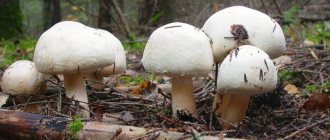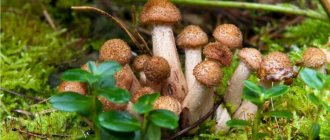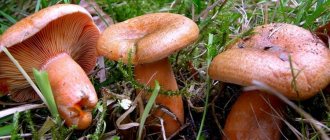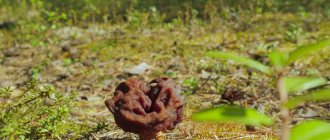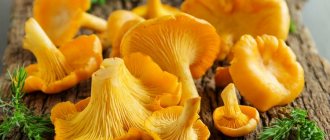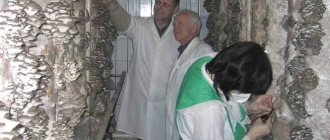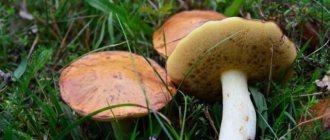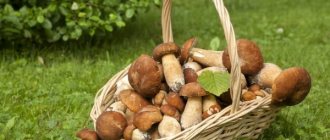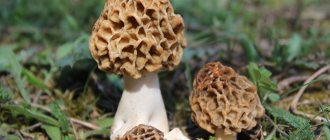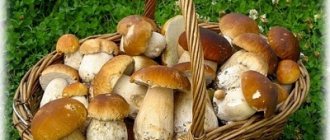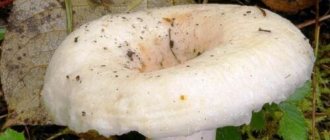Oyster mushrooms are considered unpretentious mushrooms, tolerate low temperatures well and are better suited than other species for growing at home. Where oyster mushrooms grow, namely on what trees, is of interest to all lovers of this tasty and healthy mushroom.
In this article we will look at how and where oyster mushrooms grow in nature, what trees to look for them on, what species exist and what conditions they need to be provided to successfully grow at home.
- At what temperature do oyster mushrooms grow?
- What does an oyster (ordinary) mushroom look like?
How oyster mushrooms grow in the forest
In the wild you can find several varieties of oyster mushrooms: common (oyster), abundant (horn-shaped), pulmonary (whitish), oak, late (autumn), steppe (royal), orange.
Oyster mushrooms grow in the forest on decaying wood. They can be seen on rotten stumps, in broken trunks, and on fallen trees. They are saprophytes that decompose dead organic matter. These fungi can be called predators: they secrete poisons that enter rotten wood, paralyze the nematodes living in it and obtain nitrogen from these decomposed roundworms, necessary for protein synthesis.
Oyster mushrooms are almost never found alone, more often in large groups
They grow in large groups in several tiers, quite far from the ground. They practically never occur alone. The fruiting bodies grow together, forming bunches weighing up to 3 kg. One bunch contains from 30 fruiting bodies.
One of the most common varieties of oyster mushrooms in Russia is the common or oyster mushroom. It grows only on trees in large groups, consisting of several tiers, resembling peculiar overhanging steps. It can settle on both vertical trees and horizontal ones. In the first case, it is attached to the trunk with short legs, in the second they are longer, attached closer to the edge of the cap.
The late one forms colonies consisting of greenish or olive-colored fruiting bodies. They are located one above the other, fused with legs, forming bundles that resemble a roof.
The abundant one is attached to the bark of old deciduous trees by a long curved stalk that connects to the cap in the very center.
Pulmonary oyster mushroom is called spring or beech
The lung grows together with legs, forming large bundles. It differs from others in its white color and leg with a velvety delicate edge.
Due to its bright color, orange oyster mushroom looks very impressive in the forest; it can survive the winter, but in the spring it becomes more faded. It has practically no legs and is attached to the trunk with a cap. Usually found in small groups, single specimens are rarely seen.
The steppe settles in atypical places: in pastures, deserts, and other open spaces where there are umbrella plants.
Oak forms numerous clumps that grow in several tiers and can completely cover the rotting tree.
The covered one settles on fallen aspens and dead wood. It bears fruit in groups, but in single specimens that do not grow together. Because of this, it received an additional name - single. Attached to the trunk by a sessile dense cap without a stem.
Colony of mushrooms on an old tree
Useful qualities
Mushrooms are in third place in terms of calories, after meat. They have a number of useful components for humans:
- Amino acids;
- Minerals: iron, iodine, potassium;
- Vitamins.
Making oyster mushroom tinctures with alcohol helps in the fight against diseases such as:
- Hypertension;
- Tumor diseases;
- Obesity;
- Bad cholesterol;
- Atherosclerosis.
Do not forget that oyster mushrooms contain chitin, which is difficult for the human body to digest. You need to chop the mushrooms very finely and cook for a long time. Not everyone can eat these mushrooms. There are categories of people who are not recommended to use them.
These include:
- Children under 5 years old;
- Teenagers - they are allowed rarely and in small quantities;
- Aged people;
- People suffering from liver and kidney diseases;
Doctors do not recommend eating oyster mushrooms more than 2 times a week. For serious illnesses, it is better to stop using them.
Home-grown oyster mushrooms will not be as fragrant as their forest counterparts, but they will be environmentally friendly and safe for consumption. Tasty and nutritious mushrooms are easy to grow with your own hands; you just need to follow clear instructions and put in as much effort as possible.
Where do oyster mushrooms grow in Russia?
In our country they are found everywhere: in Europe, Siberia, and the Far East. The middle zone, Krasnodar Territory, Primorye, and the Caucasus are especially abundant in them.
In the Moscow region, four varieties of oyster mushrooms grow: common (oyster), carob-shaped (abundant), autumn (late), oak, lemon (ilmak). There are especially many of them in the Kolomna region.
Royal oyster mushroom (eryingi, white steppe mushroom) grows in the southern regions of Russia, in the steppe and desert climate zone.
Royal oyster mushroom is especially valued by mushroom pickers for its good taste.
In the Caucasus, on beech trunks you can find Florida oyster mushroom, native to North America.
Corniculate is common in central Russia, the Caucasus, Primorsky Krai, and Ukraine.
The orange oyster mushroom lives in the temperate climate zone in the Northern Hemisphere. Found in Europe, including Russia, and North America.
Lemon (ilmak) grows in the south of the Far East (in the Primorsky Territory).
Covered is common in the northern and southern regions of Europe.
How long does it take for mushrooms to grow after cutting? Features of growth and development of mushrooms
Most mushrooms grow within two weeks. In this short period of time, the mushroom manages to reach standard sizes, but often growth stops already on the fifth day. Interestingly, the diameter of the fruiting body continues to increase even after upward growth has stopped. Looking at the mushroom, you can decide that its cap takes the longest to grow, and this is true.
Its development most actively occurs after the end of the growth period of the leg; the diameter increases due to growth along the periphery. This is due to the fact that the stem itself is the connecting component between the cap and the main mass of the mycelium. But at the same time, the stalk itself is a structural component of the mycelium. The thinnest strands of micelles rise above the surface, merge and form something similar to a fruiting body.
And after a week we can see a classic mushroom, which, after a detailed examination, must be sent to the basket.
A careful inspection is a strictly necessary measure, because even edible mushrooms can cause poisoning. Poisonous mushrooms are dangerous due to toxins, but edible ones can grow next to busy sections of highways, collecting all the elements of the periodic table. And measures to trim the fruiting body will not help, because heavy metals settle in the soil.
It is from this soil that the mycelium micelle receives nutrients, develops and gives rise to new fruiting bodies. So don’t be lazy to go some distance from any highways, to the permanent paths of mushroom pickers.
Another feature of mushrooms is that they are practically not processed in our intestines, like fiber. Thanks to this, mushrooms are able to improve motility and normalize the functioning of the gastrointestinal tract.
What trees do oyster mushrooms grow on?
They prefer deciduous trees - linden, aspen, oak, willow, rowan, birch. Sometimes oyster mushrooms grow on poplars and chestnuts. It is much less common to see this mushroom on conifers.
Attention! It is not recommended to collect oyster mushrooms from poplar, since its fluff carries plant pollen, which are allergens.
Mushrooms settle on the organic remains of deciduous shrubs and trees: old or rotting wood, which contains a lot of nitrogen, which is necessary for the nutrition of oyster mushrooms. They absorb lignin and cellulose from the substrate. Suitable for them are dead wood, dead wood, living weak trees, stumps covered with moss, and logging residues.
The common one settles on the trunks and stumps of deciduous trees.
Royal (steppe) grows not only on stumps, but also on dead umbrella plants, such as bluehead, gladysh, ferula.
Oyster mushroom is distinguished by high legs and deep funnels
Carob-shaped is found on deciduous trees, preferring the stumps and trunks of birch, elm, and maple trees. She settles on old oaks and rowan trees. It loves hard-to-reach places: windbreaks, clearings, difficult-to-pass bushes, dead wood, so its colonies are inconspicuous and go unnoticed by mushroom pickers.
Pulmonary prefers old birches, beech trees, aspens, and oaks. Grows on rotting wood, occasionally on living but weak or diseased trees.
Autumn oyster mushroom has a greenish tint and a bitter taste.
The late one grows on deciduous trees, less often on conifers. Loves leftover wood and stumps of such species as maple, poplar, aspen, linden, birch, elm.
The orange one is found infrequently, prefers deciduous and coniferous species, and is found on stumps and fallen trees.
The oak tree settles not only on the remains of oak trees, but also on other trees, for example, elm.
Lemon bears fruit on elms (elms): dead wood, dead or live. It grows in mixed forests, where there are broad-leaved and coniferous trees. In more northern latitudes it can settle on birch trunks.
Ilmakh performs a decorative function, decorating the forest
What methods can you use to grow mushrooms?
There are two ways to grow oyster mushrooms.
We talked in more detail about growing oyster mushrooms at home here.
Intensive
The intensive method is artificial, since cultivation is carried out in bags. If you choose this method, always keep the instruments and room sterile. It is necessary to work with gloves: when the mycelium warms to room temperature, grind it - 1 kg of 10 kg of soil. The latter can be made of straw or tree leaves. Make sure there are no signs of mold or rot. It is also necessary that the soil undergoes heat treatment and is moist during planting of the mycelium.
There are two ways to place soil with mycelium in a bag - mix the components or lay them in layers. After this, make small cuts in the bags and arrange them so that air gets in. You can harvest your first harvest in about 1.5 months.
Extensive
With the extensive method, the growing process will take place in a natural environment. For example, you can graft mycelium onto various trees - aspen, linden, poplar. To do this, wet the log with water and make a couple of deep cuts. Place the mycelium in the latter and cover with moss/tree bark. The place where you bury these logs should be in the shade. Be sure to water thoroughly. The first harvest can be harvested in 1.5-2 months.
When oyster mushrooms grow
It is impossible to accurately determine the appearance of fruiting bodies in the forest. This depends on weather conditions, which differ from year to year.
In warm regions of Russia, oyster mushrooms appear from April to November, in more northern regions - from August to September. You need to focus on air temperature and precipitation. Under favorable conditions, it can bear fruit until frost.
For oyster mushrooms to grow, the following conditions are necessary:
- Increased air humidity, which occurs after heavy rains.
- Air temperature from 8 to 17 degrees.
Oyster mushroom, or oyster mushroom, appears at the end of summer and pleases mushroom pickers until late autumn, sometimes until December. Under favorable conditions, you can meet it as early as May.
Pulmonaria and cornaceae are heat-loving species; you need to go for them in the middle of summer, in hot weather, when they are actively growing. The period of abundant fruiting of oyster mushroom is from May to early September; it is afraid of frost and loves moisture, so it bears fruit en masse during the rainy season - at the beginning of summer and towards the end of autumn. The pulmonary grows from May to October.
Steppe, or royal, bears fruit only in the spring months. In the south it appears already in early March.
Autumn grows from September until December, until frost and snow. For fruiting bodies to appear, a rise in temperature of only 5 degrees is sufficient.
The fruiting time of orange oyster mushroom is from early autumn to November. In warmer regions it grows in winter.
Oak can be found from July to September.
Lemon appears in May and bears fruit until October.
The antlers begin to appear in the spring (April), around the same time as the morels/stripes. It grows especially actively in May. The fruiting season ends in July.
Is it possible to grow this type of mushroom yourself?
It is not difficult to grow oyster mushrooms yourself at home. The process does not require serious financial investments, but you will get a large harvest - 1 kg of mycelium produces 4 kg of mushrooms. Open ground or indoors are suitable for cultivation. Mycelium is sold in specialized stores. High-quality mycelium is usually white or orange with red splashes. After purchasing, it is better to keep it in a cool place for 14 days to a month.
When to collect oyster mushrooms in the forest
The season for collecting oyster mushrooms depends on its variety, climate of the area, and weather conditions. In general, they bear fruit from spring to mid-autumn. The traditional time for collecting oyster mushrooms in Russia is September–October. It is at this time that the autumn or late oyster mushroom bears fruit.
The ripeness of the mushroom is indicated by open plates, ready for sporulation; the fruiting body becomes thin and light.
One bunch can weigh up to 3 kg
Description and appearance
Oyster mushroom is a conditionally edible mushroom that rarely grows alone, more often in groups. Its features:
- Hat. Diameter from five to fifteen centimeters. It has a fleshy, solid structure. Most often it has a round shape with a thin edge, but it can also be ear-shaped. In young fruits it is more convex, in old ones it is flat.
- Pulp. It has a white tint and is dense. As the mushroom ages, it changes from very soft and juicy to hard and fibrous. It has a pleasant taste.
- Leg. Short and slightly curved. Its length is from two to five centimeters, and its thickness is from 0.8 to 3 cm. The shape resembles a cylinder, narrowed at the base. Features a smooth white surface.
How to cut oyster mushrooms correctly
They bear fruit in large conglomerates, fused with fruiting bodies. It is recommended to cut them with a sharp knife, being careful not to damage the rhizome. You need to remove everything at once, even if there are small specimens in the bunch: if you leave the small ones, they will die anyway.
You should take mushrooms whose caps do not exceed 10 cm in size: these are most suitable for eating because they have a delicate structure, unlike older specimens.
It is better to leave wet fruit bodies as they will begin to rot very quickly.
Some people advise eating only the caps, and cutting off the hard stems and discarding them. But experienced mushroom pickers believe that they should be used. The fact is that the legs require longer heat treatment. You can make delicious soup, caviar or sauce from them.
Important! For cooking, you need to take only the stems of young mushrooms. It is better not to use old ones, since they have lost their aroma and taste and do not soften when cooked, but become rubbery.
Nutritional value
Based on their nutritional value, oyster mushrooms can be divided into four categories. Usually all representatives of this family are edible, but there are false mushrooms and here you need to not confuse their description and avoid mistakes when collecting. Only five species out of nine varieties are considered the best for eating, since the rest of the species have hard and fibrous flesh.
It has been proven that a 100 gram serving of raw mushrooms contains:
| Squirrel | 3.31 grams |
| Zhirov | 0.41 grams |
| Carbohydrates | 4.17 grams |
| Alimentary fiber | 2.3 grams |
| Ashes | 1.01 grams |
| Water | 9 grams |
It is known that 100 grams of such a product contains approximately 34 kcal. In addition, it contains vitamins and macro- and microelements:
- Vitamins B.
- Vitamins PP.
- Vitamins C.
- Vitamins D.
- Phosphorus.
- Iron.
- Copper.
- Selenium.
- Potassium.
- Zinc.
Such a rich composition of this mushroom plant allows it to be used to treat many diseases. It is known that these representatives of the mushroom kingdom are completely safe, since they do not accumulate toxins. But still, like any mushrooms, they are considered heavy food.
Oyster mushrooms in the forest. How they grow. How to recognize.

